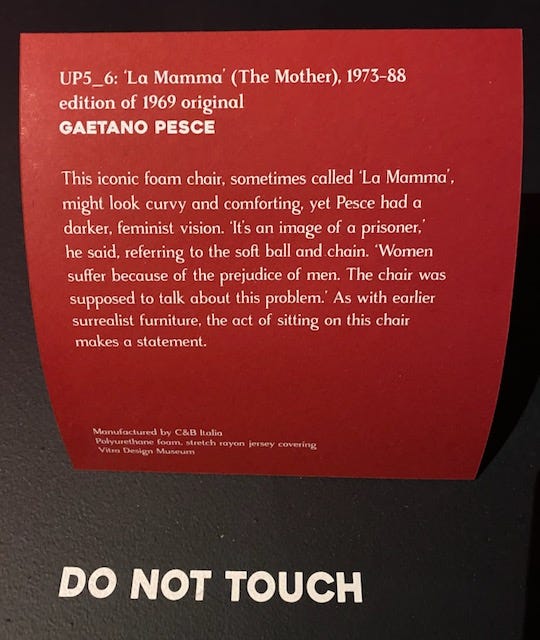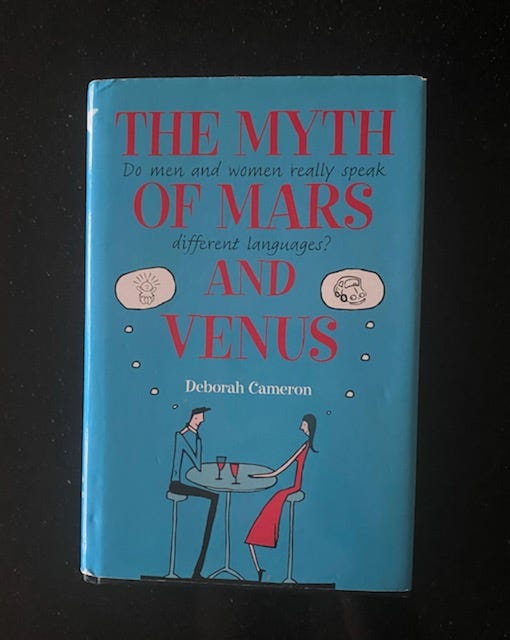How a Chair Inspired a Newsletter on Language Policing of Women & Multilinguals
On the difference between the how & what of communication, accentism, why accent reduction is never the answer & my favourite feminist linguists
I took my children to the surrealism exhibit at the Design Museum last week. My son loves fantasy books so I assumed it would be interesting and inspirational for him. But that day, my expectation did not match reality. My kids were either bored or fighting and mostly, weirded out by the art because surrealism is super weird. My daughter watched Björk videos on a loop and my son mostly sat in the corner of each dimly lit room reading his fantasy book. The one thing that held their attention for more than a couple of seconds, besides the Björk videos, was a massive bulbous red sculpture, soft and inviting and perfect to throw yourself at. It reminded them of a huge bean-bag chair, they said, as they begged to sit on it.
The globular sculpture was La Mamma (The Mother) by Gaetano Pesce. First created in 1969, Pesce said it represented the female form and symbolized an image of a prisoner: “Women suffer because of the prejudice of men. The chair was supposed to talk about this problem,” Pesce has been quoted numerous times. The ottoman, in the shape of a ball, is attached by a thin cord, or the ball and chain of women’s imprisonment. One writer interpreted it as an umbilical cord, calling it, “mother’s little ball and chain”. You can read more about its history here, here and here.
In honour of the chair’s 50th anniversary in 2019, a giant edition, complete with piercing arrows, was installed in Milan for the design fair. Journalists and critics rightfully argued that this was not feminism, women are not furniture, and what was perhaps revolutionary in 1969 is no longer the conversation we desperately need for women’s rights and against the violence women face every day. The male CEO of B&B Italia, the producer of the (regular-sized) chair, noted in an interview that it is among the company’s best-selling armchairs. Aww men profiting off women’s suffering — how novel.
But this Pesce quote got me the most, especially the use of “unwittingly”:
“At that time, I was seeking to tell a personal story about my concept of women: I believe that women have always unwittingly been their own jailer. This is why I decided to give this armchair the shape of a woman with a ball and chain, reflecting the traditional image of a prisoner.”
Let me bring it back to language here as this quote reminded me of how, not only women, but also multilinguals whose dominant language is not English, are constantly policed, judged, and made to feel like they are the problem, the unwitting prisoners, because of the way they speak, sound, or communicate.
Over the past decade, there have been numerous articles about women’s language: it is too feminine, too apologetic, not corporate, or assertive enough. But don’t worry, the articles continue, we know how to help you stop saying sorry, just and ummmm and start speaking… like a man! The two most common criticisms associated with women’s voices include upspeak (raising one’s voice at the end of a sentence) and vocal fry (drawing out the end of words or sentences with a creaky, low voice). Thankfully, there have also been numerous articles rightfully defending women’s voices, the way they speak and communicate, highlighting that in fact, there is absolutely no scientific evidence that gendered language is real, men do similar things all the time and no one notices, and women should never have to speak like men. And yet, the cycle of back-and-forth discussions persists. Most recently I noticed criticisms about the way women write emails and how, among other “corrections” they need to get rid of the exclamation marks. If I have to say it a million times, I will: EXCLAMATION MARKS ARE NOT THE PROBLEM!!!!
As many other linguists before me have noted, often while being interviewed for articles or books on the policing of women’s language, there is no scientific evidence to back up any of this. And even when we look at gendered language, it is complicated in that often women are, from a very young age, socialized to speak and communicate a certain way because certain behaviours and communication qualities are defined as either masculine or feminine. Language is about communication but also about relationships and connection.
“All the discussion is about what we think we hear,” the feminist linguist Robin Lakoff said in an article in The Cut. “With men, we listen for what they’re saying, their point, their assertions…With women, we tend to listen to how they’re talking, the words they use, what they emphasize, whether they smile.” Lakoff is the author of Language and a Woman’s Place, originally published in 1972. Yes, that is right, 1972! As feminist linguist Deborah Cameron writes, also in the same article, these sorts of notions are over-generalizations and often lies, “none of them are true for every woman in every context (or even most women in most contexts).”
It is this how and what that extends to policing language in multilingual contexts. When we consider the idea of accent, for example, people use phrases like “thick accent” as an excuse for not understanding someone who simply sounds different than they do. The focus is on the how and not the what. If the focus is on the what, it is almost always possible to understand the main message, no matter what a person sounds like.
On the topic of accents, I’ve have had countless conversations with mothers who are petrified of passing on an accent to their children out of fear the children will be discriminated against like they were. This is a direct result of accentism, discrimination based on how someone sounds or speaks. In some families, parents will self-police language and the results can be detrimental to family cohesion and healthy emotional bonds between parent and child. The discriminatory and racist practice of “accent reduction” (ex. working with a “coach” to change the way someone sounds) is part of this conversation. As Vijay, Ramjattan, a fellow linguist whose work I follow closely and admire says, “do not change accent, change institutional prescriptions about accent.”
I will write more on accent and accentism in a future newsletter, but I leave you with this: when someone claims intelligibility because of an accent, or in the case of women, declares they lack assertiveness and intelligence because of the way they sound or write emails, put the onus on that person, the listener or the reader. Conversations and dialogue do not occur in isolation but between two or more people who are both/all responsible for communication.
Back at the Design Museum, unfortunately my children were not allowed to sit on La Mamma. They would have looked adorable, nestled in, enveloped by the bulbous forms, the tits, the thighs of Pesce’s woman and mother. They probably would have splayed themselves over the ball ottoman, rolled around on it, pulling on the chain, and jumping on the chair before I whisper-yelled to stop putting their shoes all over the furniture. We talk a lot about inequality, racism, sexism, patriarchy, and misogyny in our home because we want our children to know how to fight against it any chance they get. We want them to know how to apologize, when is the right time to apologize but also to never apologize for being them, for taking up space, for knowing how they feel and what they want or how they communicate in the world. I agree with Pesce in that women, but also marginalized groups, immigrants, certain multilinguals whose languages are not considered “prestigious”, are often prisoners in the system, in society. But it is the knowing that gives us power to fight back, because exclamation marks are never the problem!
A few more related things:
· As a woman and Canadian, if I had a dime for every time someone told me I apologize too much… I’ve even been told I say “sorry” in a “very Canadian way” hmmm let that sink in.
· I linked to author and journalist Jessica Grose’s article about the Just Not Sorry Chrome extension above but also wanted to note an interview she did with NPR when her voice was policed by listeners of a podcast. And if you didn’t hear, Grose just published a brilliant book on motherhood in America, Screaming on the Inside: The Unsustainability of American Motherhood. I quoted it on Instagram here, and if you want to read some brilliant Q&As with Grose, I recommend this one (The Same Shit in a New Package!) by Sara Petersen of
, this one by of and this one by Sara Fredman of.· Speaking of same shit… the dedication in my 1975 copy of Robin Lakoff’s book (originally published in 1972) is to her son, Andy and reads: “whose generation will, I hope, have transcended these issues by the time it can read this book.” Onward, we keep going for the next generation!











What to say about ‘unwittingly’ and also about saying sorry and being socialized to say sorry as a woman and a minority and also about being angry so angry about it all and so much more! Malwina, I have become militant about not wasting my life reading or absorbing crap. Time reading your thoughts is time spent wisely. Thank you!